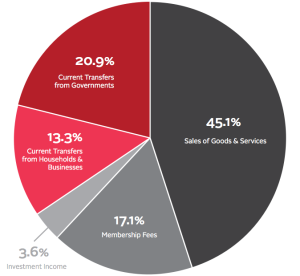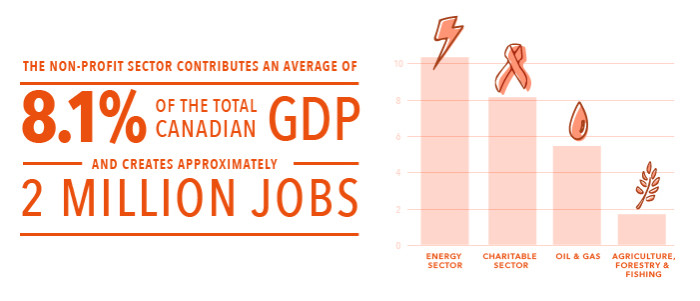Canada’s Charitable Sector is Growing, but it Needs More Support
July 13, 2015
5 min read
A June report by Brian Emmett, Imagine Canada’s chief economist for Canada’s charitable and nonprofit sector, shows that the country’s charitable sector is expanding. So much so that it has become “a major sector in Canada, supporting a large number of jobs and creating significant economic growth.”
Charities in Canada as an Economic Sector outlines the charitable sector’s growth over the last decade, noting that it has overtaken the construction, agricultural, forestry and utilities industries in terms of employment, and reached a point where it’s nearly on par with manufacturing, with about 10% of working Canadians employed in the charitable sector.
“The charitable sector in Canada is simply too large and significant NOT to be looked at through the same lens as other economic actors.”
— Brian Emmett
What’s Driving the Growth?
Canada’s Charitable Sector by the Numbers
85,000: approx. number of registered charities in Canada
360: net annual growth in number of new Canadian charities
6.4%: annual growth rate in charitable sector (vs. 5.6% annual GDP growth)
10%: percentage of working Canadians employed in the charitable sector
90%: percentage of charity employees with some post-secondary education
According to the report, several factors have led to the charitable sector’s growth.
Low barrier to entry
Hundreds, and sometimes thousands, of new charities are registered every year in Canada, a trend that has been consistent for the past 10 years. But while the barriers to entry for new charities are relatively low, the barriers to success are also high, resulting in the loss of hundreds of charities every year. The net result is a sector that grows by about 360 charities per year.
Demand for social services
According to the report, growth in the sector is not driven by supply but by demand. As the population grows and ages, and Canadians require more social services, the charitable sector — and enterprising charitable Canadians — respond.
“As population grows, ages and becomes more diverse and as economies become richer, the demand for the services that the sector provides — health, social services, recreation, culture and so on — tend to increase. The growth of the charitable sector is thus driven by demand and value the sector produces,” Emmett writes.
Decline in government spending on social services
With the current government trend toward cutting social services spending, charities have stepped up to fill in the gaps. “The picture this paints is one of a Canada which is taking on a different character, one in which government will do less and charities will need to do more,” Emmett writes. “Since overall federal spending is declining in relation to GDP, so is overall federal spending on social programs.”
Implications for Charities and Canadians
As the charitable sector becomes an increasingly important economic driver and social services provider, it requires support and innovation to grow and evolve.
With government support on the decline, charities are being forced to rely more heavily on donations to fund their programs and services. But Emmett writes that funding models in the charitable sector are generally “based on avoiding risk rather than experimenting with new approaches that might increase effectiveness.” And that has resulted in a lack of innovation in the sector.
Currently, donations account for only 13% of income for charities and non-profits, and that has been decreasing since 2007.
 To increase donations, Emmett suggests charities work with government to incentivize giving, and to adopt a business-oriented mentality when it comes to using innovative approaches to diversify revenue sources.
To increase donations, Emmett suggests charities work with government to incentivize giving, and to adopt a business-oriented mentality when it comes to using innovative approaches to diversify revenue sources.
This includes better collection of data and insights on donor motivations, and more relevant ways to reach donors — particularly younger demographics.
“These trends suggest that charities are failing to attract younger donors who are entering the workforce for the first time. If charities fail to innovate, people might perceive them as old fashioned and ineffective, which would make them less likely to donate.”
How to Diversify Your Resources and Reach Young Donors
According to the report, donors are getting older, and younger generations aren’t filling in the gaps.
“From 1997 to 2012, the percentage of donors between the ages of 55 and 64 increased by 7% from 14% to 21%. The percentage of donors above the age of 65 also increased by 3%, from 23% to 26%. These increases came at the expense of younger groups of donors. The percentage of donors aged 35 to 44 decreased by 8%, while the percentage of donors aged 25 to 34 decreased by 2%.”
Reaching younger donors requires an understanding of how and why they give. These resources can help you tap into the motivations of the younger generation:
Want to make giving to your charity easier? We can help! Get in touch to claim your free Chimp Charity Account. Call us for more info at 1-877-531-0580 or email [email protected].

